F5-TTS is an open-source voice cloning tool from Shanghai Jiao Tong University with excellent results. The initial version only supported Chinese and English cloning, but the latest version v1 has been extended to support multiple languages such as French, Italian, Hindi, Japanese, Russian, Spanish, and Finnish.
This article mainly introduces how to install and start F5-TTS using the official source code, and how to connect it with the pyVideotrans project. In addition, it will also introduce how to achieve LAN (Local Area Network) calls by modifying the source code.
At the same time, due to limited energy, I will no longer maintain the previous personal integration package and API interface, but instead unify the use of the official interface to connect with the pyVideotrans project. The limitation of the official interface is that it can only be called locally and cannot be called within the LAN. Please refer to the LAN usage section of this article for the solution.
Prerequisites
Your system must have Python 3.10 installed. Although versions 3.11/3.12 may theoretically work, they have not been tested, so it is recommended to use version 3.10.
If Python is not installed:
Windows system installation tutorial: https://pvt512.com/20250313/pythoninstall
Mac system installation: If not installed, please visit the Python official website to download the pkg installation package https://www.python.org/downloads/macos and select the
3.10.11version.
Check if Python is installed:
- Windows system: Press Win+R, enter
cmdin the pop-up window and press Enter. Enterpython --versionin the opened black window. If3.10.xxis displayed, it means it is installed; if it prompts "python is not an internal or external command", it means it is not installed or Python has not been added to the Path environment variable, and it needs to be reinstalled. - Mac system: Directly execute
python3 --versionin the terminal. If3.10.xis output, it means it is installed; otherwise, it needs to be installed.
Download F5-TTS Source Code
First, create an empty folder in a suitable location. It is recommended to choose a non-system disk, a location that does not require special permissions, such as the D drive, etc. Avoid placing it in directories like C:/Program Files (it is recommended that the location and each level of folder use names composed of pure numbers or letters), to avoid potential problems. For example, D:/f5/v1 is a good location, while D:/开源 f5/f5 v1 with spaces and Chinese characters is not recommended.
This article takes installing F5-TTS in the D:/python/f5ttsnew folder of the Windows10 system as an example.
Open the website: https://github.com/SWivid/F5-TTS
As shown in the figure below, click to download the source code:
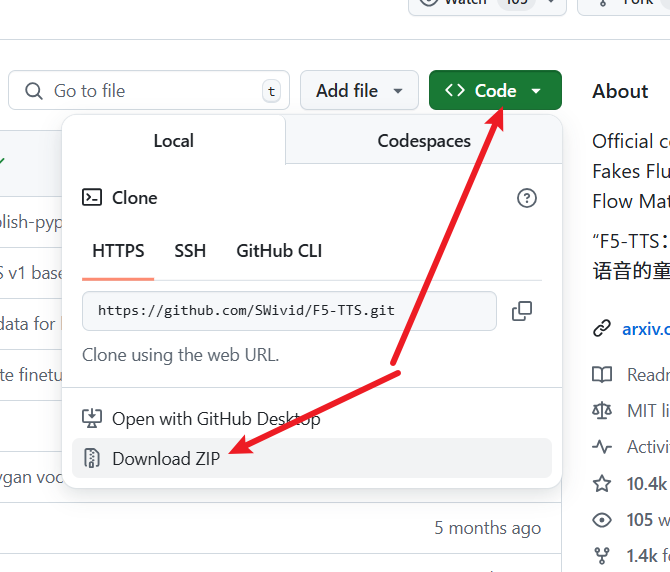
After the download is complete, unzip the compressed package and copy all the files in the F5-TTS-main folder to the D:/python/f5ttsnew folder, as shown in the figure below:
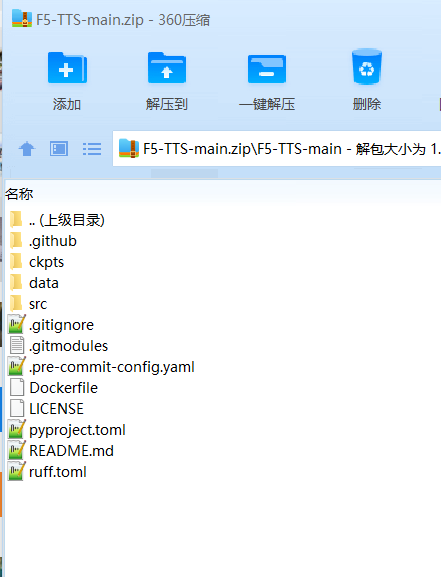
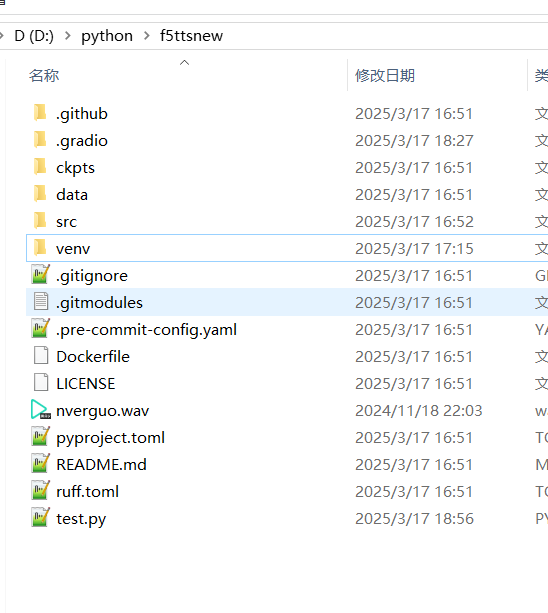
Create a Virtual Environment
It is highly recommended to create a virtual environment unless your computer does not have other Python projects or AI projects. A virtual environment can effectively avoid many potential errors.
Enter cmd in the address bar of the newly created folder D:/python/f5ttsnew and press Enter (Mac system please use the terminal to enter the folder).
Execute the following command to create a virtual environment: python -m venv venv. After execution, a folder named venv will be added to the folder.
Next, activate the virtual environment (note the spaces and dot symbols):
- Windows system:
.\venv\scripts\activate - Mac system:
. ./venv/bin/activate
After the virtual environment is activated, the characters (venv) will be added to the command line prompt. Please be sure to ensure that all subsequent operations are performed in this virtual environment, and check whether the command line prompt has (venv) before each operation.

Install Dependencies
In the terminal with the virtual environment activated, continue to enter the following command (note the spaces and dot symbols):
pip install -e .
Wait for the installation to complete. If CUDA acceleration is required, continue to execute the following command (this is one line of command, do not wrap):
# Install pytorch with your CUDA version, e.g.
pip install torch==2.4.0+cu124 torchaudio==2.4.0+cu124 --extra-index-url https://download.pytorch.org/whl/cu124Configure Scientific Internet Access Environment
Important Note: F5-TTS needs to download models online from the huggingface.co website. Since this website has been blocked in mainland China and cannot be directly connected, you must configure the scientific internet access environment and enable global or system proxy before starting.
If your VPN tool provides an HTTP port (as shown in the figure below):

Please enter the following command in the terminal to set the proxy:
- Windows system:
set https_proxy=http://127.0.0.1:10808(Please replace the port number with the actual port you are using) - Mac system:
https_proxy=http://127.0.0.1:10808(Please replace the port number with the actual port you are using)
You can also directly modify the code to set the proxy to avoid manually entering it in the terminal each time. Open the F5-TTS root directory/src/f5_tts/infer/infer_gradio.py file and add the following code at the top of the file:
import os
os.environ['https_proxy']='http://127.0.0.1:10808' # Fill in according to your actual proxy addressStart the WebUI Interface
After configuring the scientific internet access environment, enter the following command in the terminal to start the WebUI:
f5-tts_infer-gradio
The first time you start it, the program will automatically download the model. The process may be slow, so please be patient. When starting later, the program may still connect to huggingface.co for detection. It is recommended to keep the proxy turned on to avoid errors.
After the startup is successful, the terminal will display the IP address and port number, as shown in the figure below:
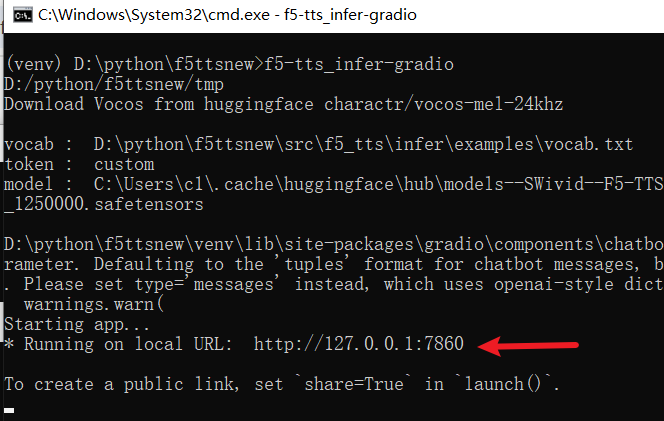
Open the displayed address in the browser, which is http://127.0.0.1:7860 by default.
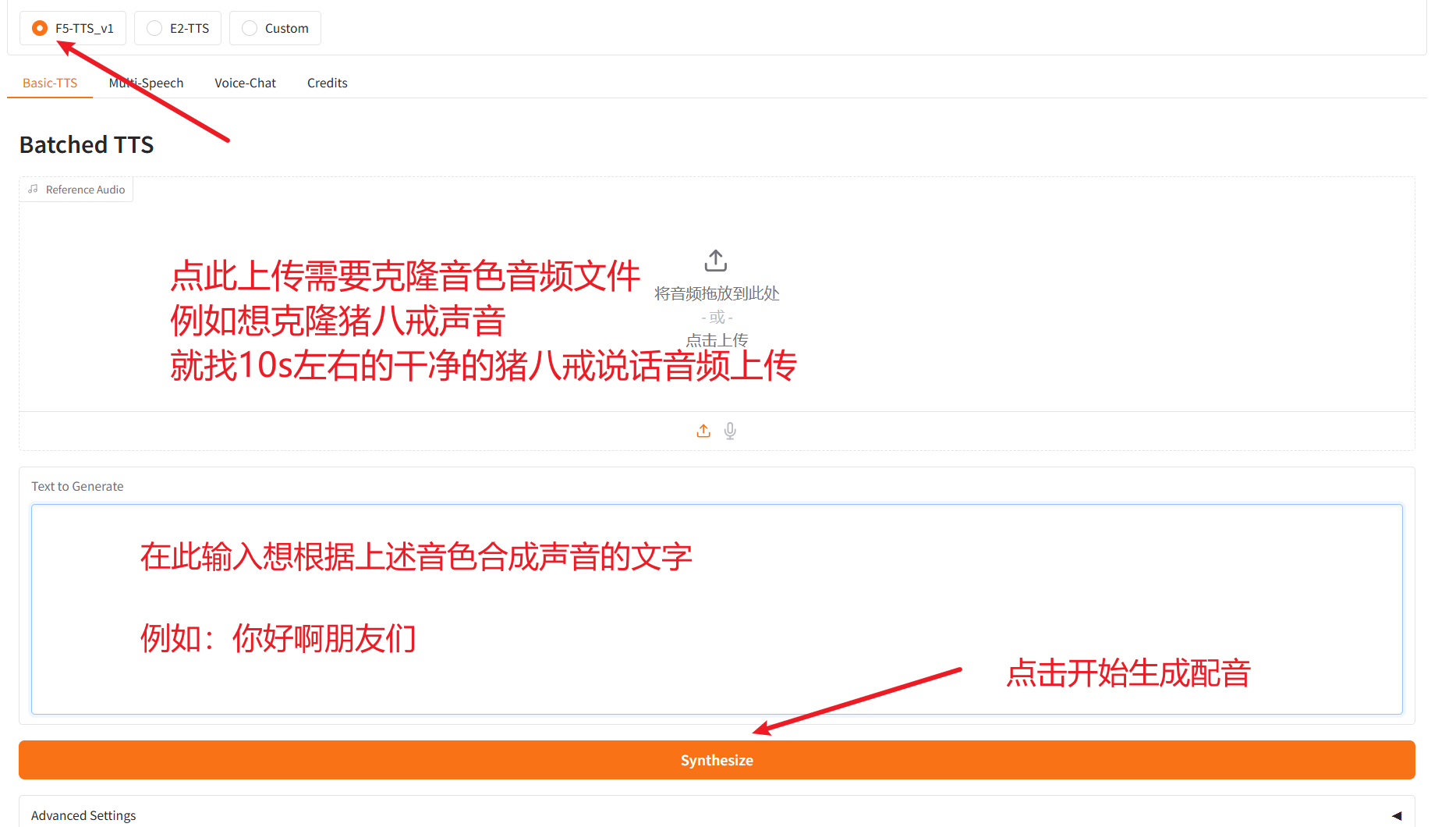
Connect to pyVideoTrans API
In order to use F5-TTS in video translation software, you need to start F5-TTS first and keep the terminal window open.
Then, open the video translation software, and select "TTS Settings" -> "F5-TTS API" in the menu, and fill in the startup address of F5-TTS, which is http://127.0.0.1:7860 by default. If your startup address is not the default address, please fill in the actual address.
In the "Reference Audio" field, fill in the following content:
Audio file name to use#Corresponding text in the audio file
Note: Please place the reference audio file in the f5-tts folder under the root directory of the pyVideotrans project. If the folder does not exist, please create it manually. For example, you can name the reference audio file nverguo.wav.
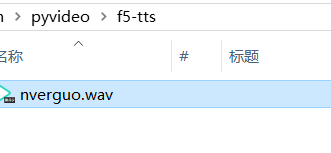
The filling example is as follows:
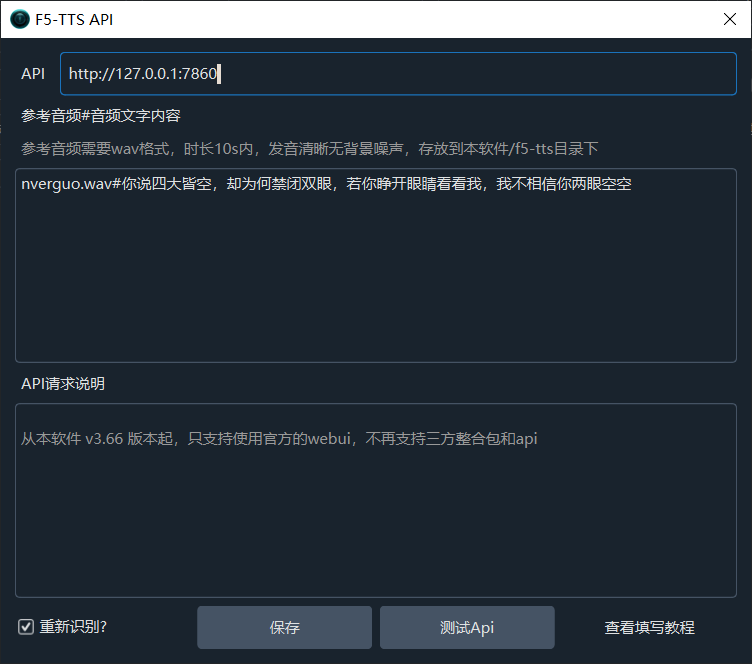
Re-identify?: By default, the reference audio (subtitles recognized during cloning) will be sent to F5-TTS to avoid F5-TTS from starting whisper to do speech recognition, saving time and improving efficiency. However, sometimes you may want F5-TTS to re-identify, which can improve the cloning quality to a certain extent. You can select this checkbox at this time, but note that if this is the first time you do this after selecting it, F5-TTS will download the openai-whisper-v3 model online from huggingface.co. Please ensure that you have scientific internet access.
Solve the LAN Problem
If your F5-TTS is deployed on another computer in the LAN, you need to modify the F5-TTS code to support LAN access.
Open the F5-TTS project directory/src/f5_tts/infer/infer_gradio.py file and add the following code below line 16:
# 新增 局域网start (Add LAN start)
import os
from pathlib import Path
ROOT=Path(os.getcwd()).as_posix()
TMP=f'{ROOT}/tmp'
Path(TMP).mkdir(exist_ok=True)
os.environ['GRADIO_TEMP_DIR']=TMP
gr.set_static_paths(paths=[TMP,tempfile.gettempdir()])
print(TMP)
## 新增局域网end (Add LAN end)Schematic diagram of code addition position: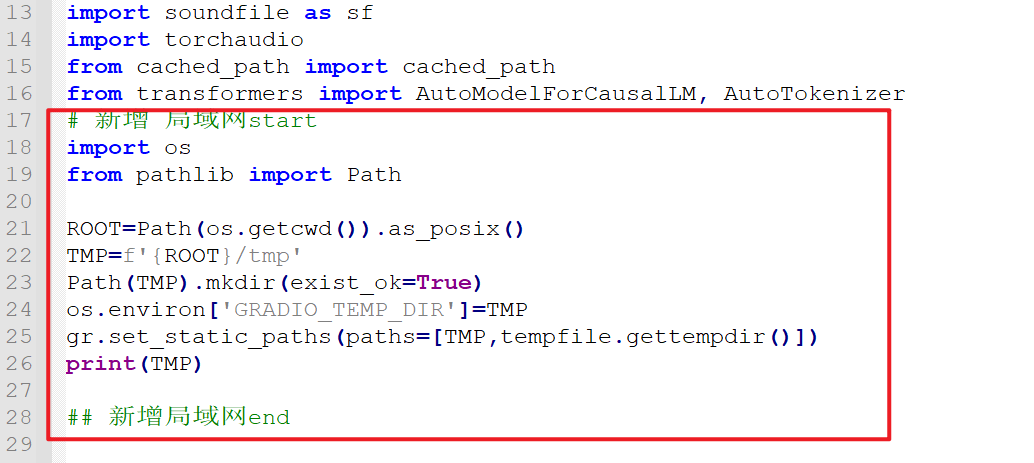
After saving the modification, restart F5-TTS. Then fill in the IP address and port number after F5-TTS is started in pyVideotrans, such as http://192.168.0.12:7860.
Add Other Languages
If you need to use models in other languages, you also need to modify the F5-TTS project directory/src/f5_tts/infer/infer_gradio.py file.
Find the code around line 59:
DEFAULT_TTS_MODEL_CFG = [
"hf://SWivid/F5-TTS/F5TTS_v1_Base/model_1250000.safetensors",
"hf://SWivid/F5-TTS/F5TTS_v1_Base/vocab.txt",
json.dumps(dict(dim=1024, depth=22, heads=16, ff_mult=2, text_dim=512, conv_layers=4)),
]Code location diagram:

By default, the official Chinese and English models are configured here. If you need to use models in other languages, please modify them according to the following instructions. After the modification is complete, you need to restart F5-TTS and ensure that the scientific internet access environment is configured so that the program can download the new language model online. After the download is successful, first clone a voice through the WebUI for testing, and then use it through pyVideoTrans.
Important Note: Before using, please make sure that the dubbing text language in pyVideoTrans is consistent with the model language selected in F5-TTS.
The following is the configuration information of each language model:
French:
pythonDEFAULT_TTS_MODEL_CFG = [ "hf://RASPIAUDIO/F5-French-MixedSpeakers-reduced/model_last_reduced.pt", "hf://RASPIAUDIO/F5-French-MixedSpeakers-reduced/vocab.txt", json.dumps({"dim": 1024, "depth": 22, "heads": 16, "ff_mult": 2, "text_dim": 512, "text_mask_padding": False, "conv_layers": 4, "pe_attn_head": 1}), ]Hindi:
pythonDEFAULT_TTS_MODEL_CFG = [ "hf://SPRINGLab/F5-Hindi-24KHz/model_2500000.safetensors", "hf://SPRINGLab/F5-Hindi-24KHz/vocab.txt", json.dumps({"dim": 768, "depth": 18, "heads": 12, "ff_mult": 2, "text_dim": 512, "text_mask_padding": False, "conv_layers": 4, "pe_attn_head": 1}) ]Italian:
pythonDEFAULT_TTS_MODEL_CFG = [ "hf://alien79/F5-TTS-italian/model_159600.safetensors", "hf://alien79/F5-TTS-italian/vocab.txt", json.dumps({"dim": 1024, "depth": 22, "heads": 16, "ff_mult": 2, "text_dim": 512, "text_mask_padding": False, "conv_layers": 4, "pe_attn_head": 1}) ]Japanese:
pythonDEFAULT_TTS_MODEL_CFG = [ "hf://Jmica/F5TTS/JA_25498980/model_25498980.pt", "hf://Jmica/F5TTS/JA_25498980/vocab_updated.txt", json.dumps({"dim": 1024, "depth": 22, "heads": 16, "ff_mult": 2, "text_dim": 512, "text_mask_padding": False, "conv_layers": 4, "pe_attn_head": 1}) ]Russian:
pythonDEFAULT_TTS_MODEL_CFG = [ "hf://hotstone228/F5-TTS-Russian/model_last.safetensors", "hf://hotstone228/F5-TTS-Russian/vocab.txt", json.dumps({"dim": 1024, "depth": 22, "heads": 16, "ff_mult": 2, "text_dim": 512, "text_mask_padding": False, "conv_layers": 4, "pe_attn_head": 1}) ]Spanish:
pythonDEFAULT_TTS_MODEL_CFG = [ "hf://jpgallegoar/F5-Spanish/model_last.safetensors", "hf://jpgallegoar/F5-Spanish/vocab.txt", json.dumps({"dim": 1024, "depth": 22, "heads": 16, "ff_mult": 2, "text_dim": 512, "conv_layers": 4}) ]Finnish:
pythonDEFAULT_TTS_MODEL_CFG = [ "hf://AsmoKoskinen/F5-TTS_Finnish_Model/model_common_voice_fi_vox_populi_fi_20241206.safetensors", "hf://AsmoKoskinen/F5-TTS_Finnish_Model/vocab.txt", json.dumps({"dim": 1024, "depth": 22, "heads": 16, "ff_mult": 2, "text_dim": 512, "text_mask_padding": False, "conv_layers": 4, "pe_attn_head": 1})]
Pay attention to official updates, and other languages can be added in a similar way. Address: https://github.com/SWivid/F5-TTS/blob/main/src/f5_tts/infer/SHARED.md
Common Errors and Precautions
During the API usage process, you can close the WebUI interface in the browser, but you cannot close the terminal window that started F5-TTS.

Can I dynamically switch the model in F5-TTS? No. You need to manually modify the code according to the above method and then restart the WebUI.
Frequently encountering this type of error
raise ConnectTimeout(e, request=request)
requests.exceptions.ConnectTimeout: (MaxRetryError("HTTPSConnectionPool(host='huggingface.co', port=443): Max retries exceeded with url: /SWivid/F5-TTS/resolve/main/F5TTS_v1_Base/vocab.txt (Caused by ConnectTimeoutError(<urllib3.connection.HTTPSConnection object at 0x000002174796DF60>, 'Connection to huggingface.co timed out. (connect timeout=10)'))"), '(Request ID: 0458b571-90ab-4edd-ae59-b93bd603cdd0)')Proxy issues. Please have scientific internet access and use a smooth proxy. Refer to the above for configuring the scientific internet access environment.
- How to prevent connecting to huggingface.co every time?
Please ensure that you have successfully cloned at least once and the model has been downloaded Open
F5-TTS root directory/src/f5_tts/infer/utils_infer.py
Search for snapshot_download and find the line of code as shown in the figure

Modify to
local_path = snapshot_download(repo_id="nvidia/bigvgan_v2_24khz_100band_256x", cache_dir=hf_cache_dir,local_files_only=True)Then search for hf_hub_download and find the 2 lines of code as shown in the figure

Modify to
config_path = hf_hub_download(repo_id=repo_id, cache_dir=hf_cache_dir, filename="config.yaml",local_files_only=True)
model_path = hf_hub_download(repo_id=repo_id, cache_dir=hf_cache_dir, filename="pytorch_model.bin",local_files_only=True)Actually, the new parameter
,local_files_only=Trueis added to the places where these 3 lines of code are called. Please make sure that the model has been downloaded to the local machine, otherwise it will report a model not found error
- F5-TTS is deployed normally, but the test in pyVideotrans returns
{detail:"Not found"}- Check if other AI projects are occupying the port. Generally, AI projects with interfaces mostly use the gradio interface, which is also 7860 by default. Close the others and restart F5-TTS
- If pyVideotrans is source code deployed, please execute
pip install --upgrade gradio_clientand then retry - Restart F5-TTS and use the command
f5-tts_infer-gradio --apito start
